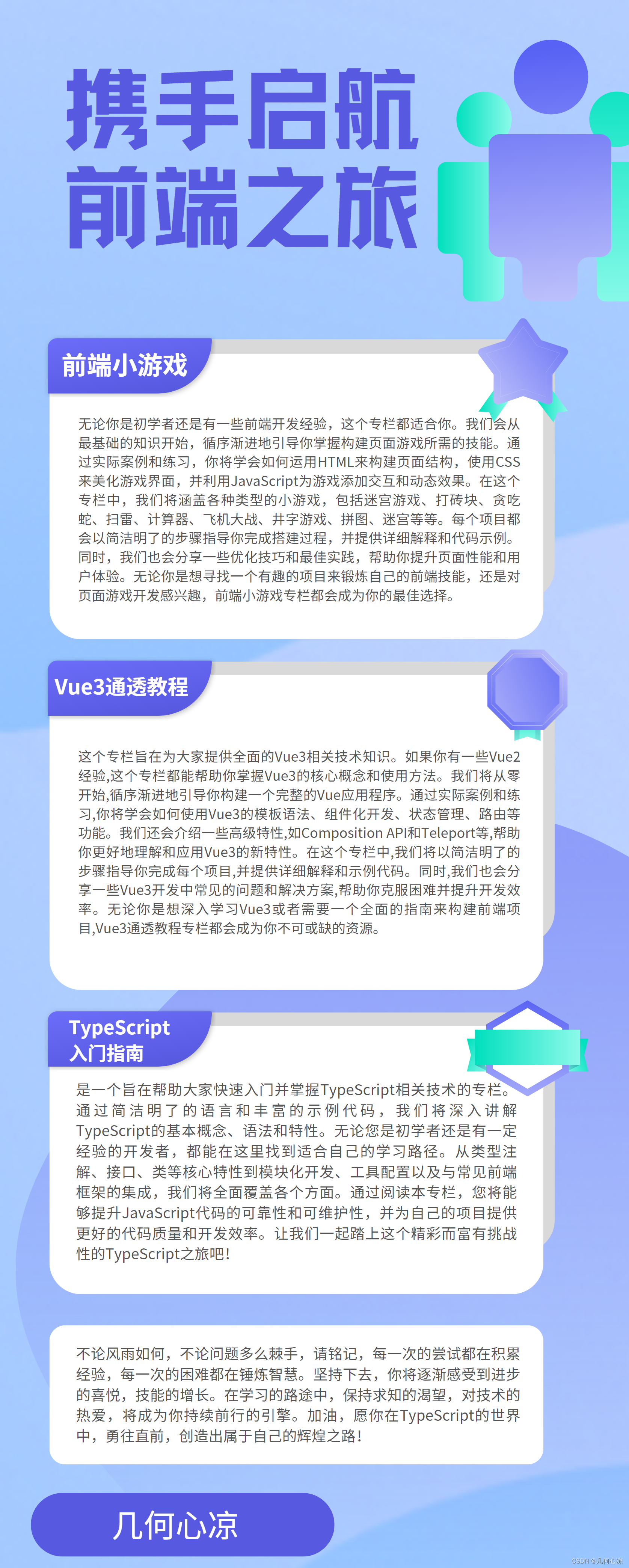Gathering sand into a tower, making a little progress every day
⭐ Column introduction
Front-end entry journey: Explore the wonderful world of web development Welcome to the front-end entry journey! If you are interested, you can subscribe to this column! This column is tailor-made for those who are interested in web development and have just entered the front-end field. Whether you are a complete novice or a developer with some basic knowledge, here will provide you with a systematic and friendly learning platform. In this column, we will update it every day in the form of questions and answers, presenting you with selected front-end knowledge points and answers to frequently asked questions. Through the Q&A format, we hope to respond more directly to readers’ questions about front-end technology and help everyone gradually establish a solid foundation. Whether it's HTML, CSS, JavaScript, or various common frameworks and tools, we'll explain concepts in a simple and easy-to-understand way, and provide practical examples and exercises to solidify what you've learned. At the same time, we will also share some practical tips and best practices to help you better understand and apply various technologies in front-end development.

Not only that, we will also regularly launch some practical project tutorials so that you can apply the knowledge you have learned to actual development. Through the practice of actual projects, you will be able to better understand the workflow and methodology of front-end development, and develop your own ability to solve problems and develop independently. We believe that only by continuous accumulation and practice can we truly master front-end development technology. So, get ready for the challenge and bravely embark on this front-end entry journey! Whether you are looking for a career change, upskilling or fulfilling personal interests, we are dedicated to providing you with the best learning resources and support. Let's explore the wonderful world of web development together! Join the front-end entry journey and become an outstanding front-end developer! Let’s start the front-end journey . The picture below introduces other columns that the blogger is outputting in addition to this column; (Skip the picture below and let’s start today’s text!!!)

⭐ Optimize front-end performance
Front-end performance optimization is one of the key aspects to ensure that a website or application performs well in terms of loading speed, responsiveness, and resource usage. Here are some ways to optimize front-end performance:
1. Reduce HTTP requests
Every HTTP request increases page load time, so reducing HTTP requests is an important step to improve performance:
- Merge files: Combine multiple CSS and JavaScript files into smaller files to reduce the number of requests.
- Use CSS sprites: Combine multiple images into a single sprite to reduce image requests.
- Lazy loading: Loading only the content of the visible area of the page, rather than loading the entire page at once.
2. Compress resources
Compress resources such as CSS, JavaScript, and images to reduce file size:
- Compress CSS and JavaScript: Use tools like UglifyJS and CSSNono to compress and obfuscate your code.
- Image Compression: Compress images using tools such as ImageOptim and TinyPNG to reduce file size.
3. Use browser cache
Enabling browser caching can reduce the number of times the same resource is loaded repeatedly:
- Set cache headers: Set appropriate cache headers on the server side to allow the browser to cache the file.
- Use versioning: Use file versioning (such as filename hashing) to ensure that the browser loads a new version when a resource changes.
4. Use a CDN
Content delivery networks (CDNs) can speed up resource loading and distribute resources to multiple locations around the world:
- CDN services: Use CDN services (such as Cloudflare and Akamai) to serve content and reduce the distance between users and servers, thereby reducing load times.
5. Lazy loading
Delay loading of resources that are not immediately needed to improve initial page load speed:
- Lazy loading of images: Use attributes
<img>of the tagloading="lazy", or use a JavaScript library such as LazyLoad to lazily load images. - Lazy loading: only loading content when the user scrolls to the visible part, rather than loading the entire page at once.
6. Use responsive design
Use responsive design to ensure your website works well on different devices:
- Media Queries: Use CSS media queries to apply different styles based on screen size and device type.
- Flexible layout: Use flexible layout (Flexbox) and grid layout (Grid) to create layouts that adapt to different screen sizes.
7. Reduce redraw and reflow
Reduce DOM operations and style changes to reduce the number of browser repaints (Repaint) and reflow (Reflow):
- Use transform and opacity: Use the CSS transform and opacity properties instead of changing the position and size of elements directly.
- Batch DOM operations: Combine multiple DOM operations into one to reduce the number of reflows.
8. Code optimization
Writing efficient code can improve performance:
- Reduce global variables: Reduce the number of global variables to reduce naming conflicts and memory usage.
- Lazy loading of JavaScript: Load JavaScript only when needed, rather than loading all scripts when the page loads.
9. Use modern web technologies
Leverage modern web technologies to improve performance:
- Use WebP format images: WebP images are generally smaller and load faster than JPEG and PNG images.
- HTTP/2 and HTTP/3: Use new HTTP protocol versions to improve request parallelism and performance.
These are some key ways to optimize front-end performance, depending on the specific project
selection and implementation based on your needs and circumstances. Performance optimization is a continuous improvement process that requires constant monitoring and testing to ensure that a website or application remains high-performing.
⭐Write at the end
This column is suitable for a wide range of readers, and is suitable for front-end beginners; or those who have not learned front-end and are interested in front-end, or back-end students who want to better show themselves and expand some front-end knowledge points during the interview process, so If you have the basics of front-end and follow this column, it can also help you to find and fill in the gaps to a great extent. Since the blogger himself does the content output, if there are any flaws in the article, you can contact me through the left side of the homepage. , let’s make progress together, and at the same time, I also recommend several columns to everyone. Interested partners can subscribe: In addition to the columns below, you can also go to my homepage to see other columns;
Front-end games (free) This column will take you into a world full of creativity and fun. By using the basic knowledge of HTML, CSS and JavaScript, we will build various interesting page games together. Whether you are a beginner or have some front-end development experience, this column is for you. We'll start with the basics and walk you through the skills you need to build a page game. Through practical cases and exercises, you will learn how to use HTML to build page structure, use CSS to beautify the game interface, and use JavaScript to add interactive and dynamic effects to the game. In this column, we'll cover various types of mini-games, including maze games, brick breaker, snake, minesweeper, calculators, plane battles, tic-tac-toe, puzzles, mazes, and more. Each project guides you through the building process in concise and clear steps, with detailed explanations and code examples. At the same time, we will also share some optimization tips and best practices to help you improve page performance and user experience. Whether you are looking for an interesting project to exercise your front-end skills, or are interested in page game development, the front-end games column will be your best choice. Click to subscribe to the front-end games column

Vue3 Transparent Tutorial [From Zero to One] (Paid) Welcome to the Vue3 Transparent Tutorial! This column aims to provide everyone with comprehensive technical knowledge related to Vue3. If you have some Vue2 experience, this column can help you master the core concepts and usage of Vue3. We will start from scratch and guide you step by step to build a complete Vue application. Through practical cases and exercises, you will learn how to use Vue3's template syntax, component development, state management, routing and other functions. We will also introduce some advanced features, such as Composition API and Teleport, to help you better understand and apply the new features of Vue3. In this column, we'll guide you through each project in concise and clear steps, with detailed explanations and sample code. At the same time, we will also share some common problems and solutions in Vue3 development to help you overcome difficulties and improve development efficiency. Whether you want to learn Vue3 in depth or need a comprehensive guide to building a front-end project, the Vue3 thorough tutorial column will become an indispensable resource for you. Click to subscribe to the Vue3 Transparent Tutorial [From Zero to One] column

TypeScript Getting Started Guide (Free) is a column designed to help you quickly get started and master TypeScript related technologies. Through concise and clear language and rich sample code, we will explain the basic concepts, syntax and features of TypeScript in depth. Whether you are a beginner or an experienced developer, you can find a learning path that suits you here. From core features such as type annotations, interfaces, and classes to modular development, tool configuration, and integration with common front-end frameworks, we will comprehensively cover all aspects. By reading this column, you will be able to improve the reliability and maintainability of JavaScript code, and provide better code quality and development efficiency for your projects. Let’s embark on this exciting and challenging TypeScript journey together! Click to subscribe to the TypeScript Getting Started Guide column
